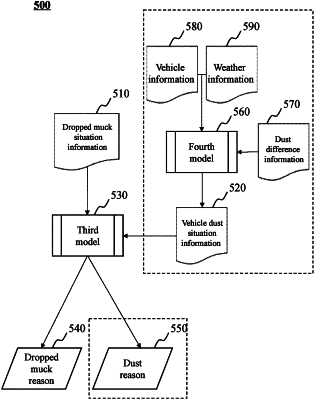| CPC G06V 20/588 (2022.01) [B65F 3/02 (2013.01); B65F 2003/0263 (2013.01)] | 4 Claims |

|
1. A method for muck truck management in a smart city based on Internet of Things, wherein the method is implemented based on a system for muck truck management in a smart city, the method is performed by a management platform, the method comprising:
obtaining construction site information;
determining a target monitoring device of a target site based on the construction site information;
obtaining muck truck monitoring data of the target site through the target monitoring device; and
generating muck truck management information by performing muck processing information analysis based on the muck truck monitoring data; wherein
the muck processing information analysis includes:
determining road status information before and after driving of a muck truck through a second model based on a second image, respectively, the second model being a machine learning model; and
determining dropped muck situation information of the muck truck based on comparative analysis of the road status information before and after driving of the muck truck; wherein
the criteria on which the comparative analysis is based includes a contrast of wheel stains, a contrast of the road, a size and number of soil stones; and the criteria on which the comparative analysis is based is adjusted according to a dust situation of the muck truck;
obtaining dropped muck situation information of the muck truck in different time periods;
determining a dropped muck reason through a third model based on the dropped muck situation information of the muck truck in the different time periods and issuing a processing instruction; wherein the dropped muck reason includes one of a problem caused by the vehicle itself and a vehicle cleaning problem at the construction site; the problem of the vehicle itself at least includes the damage of a carriage, vibration of the vehicle, the failure of an automatic coverage system; an input of the third model includes dropped muck situation information and/or vehicle dust condition information, and an output of the third model includes a dropped muck reason and/or a dust reason;
issuing different processing instructions based on different reasons of the dropped muck and/or dust produced by the muck truck; wherein
the adjusting the criteria includes:
when the vehicle dust situation information indicating the presence of dust, lowering a threshold value corresponding to the criteria, the threshold value referring to parameters used to judge a severity degree of the dropped muck situation of the muck truck; wherein
the determining the dust situation includes:
obtaining dust difference information before and after driving of the muck truck and other vehicles; and
determining vehicle dust situation information through a fourth model based on the dust difference information before and after driving of the muck truck and other vehicles in combination with vehicle information and weather information, the fourth model being a machine learning model; wherein
the third model and the fourth model are obtained by joint training, and the joint training includes:
obtaining the vehicle dust condition information output by an initial fourth model by inputting sample vehicle information, sample weather information, and sample dust difference information into the initial fourth model;
obtaining the dropped muck reason and the dust reason output by an initial third model by using an output of the initial fourth model and a sample dropped muck situation information as an input of the initial third model; and
verifying an output of the initial third model using the sample dropped muck reason and the sample dust reason, obtaining verification data of the output of the initial fourth model using reverse propagation features of a neural network model, and continuing the above training using the verification data until a trained third model and a trained fourth model are obtained.
|